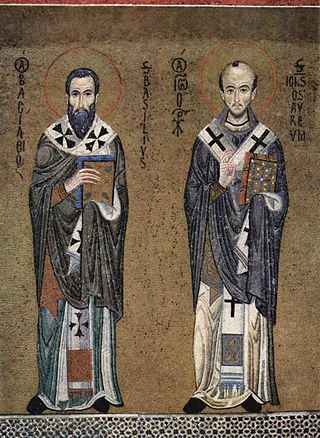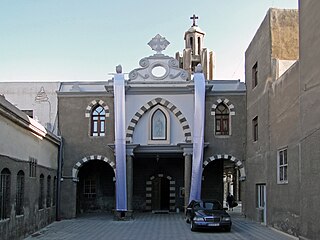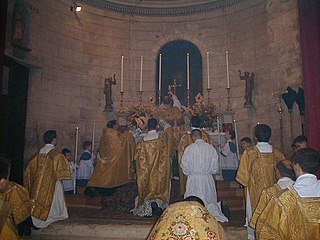| Orthodox-Catholic Church of America | |
|---|---|
| Classification | Christian syncretic (Eastern Orthodox/Oriental Orthodox/Western Catholic) |
| Orientation | Western Christianity (Latin Rite)/Eastern Christianity (Byzantine Rite/East Syriac Rite) |
| Polity | Episcopal |
| Primate | Vacant |
| Associations | Communion with Catholic Apostolic Church in North America [1] |
| Region | United States, Canada, Mexico, Brazil, Cameroon, Australia |
| Language | English |
| Origin | 1892 United States |
| Separated from | Syriac Orthodox Church (1910) |
The Orthodox-Catholic Church of America (OCCA) is an independent and self-governing Christian syncretic (Eastern Orthodox/Oriental Orthodox/Western Catholic) jurisdiction based in the United States (including the territory of the US Virgin Islands), with clergy also in Canada, Mexico, Brazil, Africa, and Australia. [2]
The church celebrates predominantly a version of the Western Liturgy (Roman Rite) though some priests also celebrate the Divine Liturgy of St. John Chrysostom (Byzantine Rite) or the Liturgy of Addai and Mari (East Syriac Rite). [3] The OCCA is not associated with the Eastern Orthodox churches whose bishops are members of the Assembly of Canonical Orthodox Bishops of the United States of America.
The OCCA is governed by a synod of diocesan bishops, currently six. The ecclesial purpose of the OCCA is to be a loving, welcoming and inclusive community where all people can attain the fundamental goal of the Orthodox Catholic faith, summed up by St. Maximos the Confessor (580-662 CE) as "All that God is, except for an identity in being, one becomes when one is deified by grace". This is effected through the worship of God in the Holy Trinity and the proclamation and living of the faith as taught in Holy Scripture, the Apostolic tradition, and the first three ecumenical councils of the Ancient church. The church recognizes sacramental ordination of women to the clergy and homosexual marriage. [4]
The OCCA is one of a number of churches practicing Orthodoxy in an American setting. Its worship and beliefs are influenced by Oriental, Eastern, and Western traditions, and considers itself to be one "self-governing" church out of many in the Orthodox tradition. [3]
The clergy ordained by the OCCA operate their ministries independently from the OCCA . According to a statement on the OCCA website:
"The relationship between the Church and the congregation, consisting of its priests, deacons and members, is based upon their shared beliefs. There is no legal relationship between the Church and the congregation." [5]
The Orthodox-Catholic Church of America was established in the United States in 1892 under the mandate of the Syriac Orthodox Patriarch, Ignatius Peter IV. The founding archbishop, Joseph René Vilatte (ordained as Mar Timotheus), had been ordained as a priest by Bishop Ernst Herzog of the Old Catholic Church in Bern, Switzerland on June 7, 1885. [6] Working in the Great Lakes area, predominantly in Wisconsin, Vilatte sought to bring about the return of a Western Rite of Orthodoxy. Fr. Vilatte received both support and opposition in this attempt, but eventually he was consecrated as archbishop for North America, in Colombo, Ceylon (now Sri Lanka) by Archbishop Francis Alvarez with the permission of the Syriac Orthodox Patriarch of Antioch in 1892. [7]
The OCCA has canonized two saints: St. David Edwards, a former priest of the OCCA, and St. Fr. Mychal Judge, O.F.M., a Catholic Franciscan friar and firehouse chaplain who was the first identified victim of the September 11 attacks in 2001. [8]
In May 1891, Bishop Vladimir (Sokolovsky), the head of the Russian Orthodox Church in the United States, referred to Fr. Vilatte's flock as "true 'Old Catholic-Orthodox Christians' [now] under the patronage of our Church". [7]

Eastern Christianity comprises Christian traditions and church families that originally developed during classical and late antiquity in Western Asia, Asia Minor, Eastern Europe, Southeastern Europe, the Caucasus, Northeast Africa, the Fertile Crescent and the Malabar coast of South Asia, and ephemerally parts of Persia, Central Asia and the Far East. The term does not describe a single communion or religious denomination.
Subdeacon is a minor order or ministry for men in various branches of Christianity. The subdeacon has a specific liturgical role and is placed between the acolyte and the deacon in the order of precedence.

Divine Liturgy or Holy Liturgy is the Eucharistic service of the Byzantine Rite, a liturgical rite developed from the Antiochene Rite of Christian liturgy which is that of the Ecumenical Patriarchate of Constantinople. As such, it is used in the Eastern Orthodox, the Greek Catholic Churches, and the Ukrainian Lutheran Church. Although the same term is sometimes applied in English to the Eucharistic service of Armenian Christians, both of the Armenian Apostolic Church and of the Armenian Catholic Church, they use in their own language a term meaning "holy offering" or "holy sacrifice". Other churches also treat "Divine Liturgy" simply as one of many names that can be used, but it is not their normal term.

The Eastern Catholic Churches or Oriental Catholic Churches, also called the Eastern-Rite Catholic Churches, Eastern Rite Catholicism, or simply the Eastern Churches, are 23 Eastern Christian autonomous particular churches of the Catholic Church, in full communion with the Pope in Rome. Although they are distinct theologically, liturgically, and historically from the Latin Church, they are all in full communion with it and with each other. Eastern Catholics are a distinct minority within the Catholic Church; of the 1.3 billion Catholics in communion with the Pope, approximately 18 million are members of the eastern churches.

The Syriac Catholic Church is an Eastern Catholic Christian jurisdiction originating in the Levant that uses the West Syriac Rite liturgy and has many practices and rites in common with the Syriac Orthodox Church. Being one of the twenty-three Eastern Catholic Churches, the Syriac Catholic Church is a self-governed sui iuris particular church, while it is in full communion with the Holy See and with the entirety of the Roman Catholic Church.

Vestments are liturgical garments and articles associated primarily with the Christian religion, especially by Eastern Churches, Catholics, Lutherans, and Anglicans. Many other groups also make use of liturgical garments; among the Reformed (Calvinist) Churches this was a point of controversy in the Protestant Reformation and sometimes since, in particular during the Anglican ritualist controversies in England in the 19th century.

The Syro-Malabar Catholic Church, is an Eastern Catholic Church based in Kerala, India. It is sui iuris (autonomous) particular Church in full communion with the Pope and the worldwide Catholic Church, including the Latin Church and the 22 other Eastern Catholic Churches, with self-governance under the Code of Canons of the Eastern Churches (CCEO). The Church is headed by the Major Archbishop of the Syro-Malabar, currently vacant. The Syro-Malabar Synod of Bishops canonically convoked and presided over by the Major Archbishop constitutes the supreme authority of the Church. The Major Archiepiscopal Curia of the Church is based in Kakkanad, Kochi. Syro-Malabar is a prefix reflecting the church's use of the East Syriac Rite liturgy and origins in Malabar. The name has been in usage in official Vatican documents since the nineteenth century.
Independent Catholicism is an independent sacramental movement of clergy and laity who self-identify as Catholic and form "micro-churches claiming apostolic succession and valid sacraments", in spite of not being affiliated to the historic Catholic churches such as the Roman Catholic and Utrechter Old Catholic churches. The term "Independent Catholic" derives from the fact that "these denominations affirm both their belonging to the Catholic tradition as well as their independence from Rome."
The Celtic Orthodox Church, also called the Holy Celtic Church, is an autocephalous Christian church founded in the 20th century in France.
The American Carpatho-Russian Orthodox Diocese of North America (ACROD) is a diocese of the Ecumenical Patriarchate with 78 parishes in the United States and Canada. Though the diocese is directly responsible to the Patriarchate, it is under the spiritual supervision of the Primate of the Greek Orthodox Archdiocese of America. The diocese was led by Metropolitan Nicholas Smisko of Amissos (1936–2011). The current leader is the Metropolitan of Nyssa, Gregory Tatsis, who was consecrated on November 27, 2012.

The West Syriac Rite, also called the Syro-Antiochian Rite and the West Syrian Rite, is an Eastern Christian liturgical rite that employs the Divine Liturgy of Saint James in the West Syriac dialect. It is practised in the Maronite Church, the Syriac Orthodox Church, the Syriac Catholic Church and various Malankara Churches of India. It is one of two main liturgical rites of Syriac Christianity, the other being the East Syriac Rite. It originated in the ancient Patriarchate of Antioch. It has more anaphoras than any other rite.

Antonio Francisco Xavier Alvares was initially a priest in the Roman Catholic Church in Goa. He joined the Malankara Orthodox Syrian Church and was elevated to Metropolitan of Goa, Ceylon and Greater India in the Malankara Orthodox Syrian Church.
The African Orthodox Church (AOC), is a predominantly African-American Christian denomination which was founded in the United States in 1918 by the joint collaboration of its first patriarch, George Alexander McGuire, and Marcus M. Garvey.
The Convergence Movement, also known as the Ancient-Future Faith Movement, is a Protestant Christian movement that began during the Fourth Great Awakening (1960–1980) in the United States.

The Priestly Society of Saint Josaphat Kuntsevych (SSJK) is a society of traditionalist priests and seminarians originating from the Ukrainian Greek Catholic Church which is led by the excommunicated priest Basil Kovpak. It is based in Riasne, Lviv, Western Ukraine. In Lviv, the society maintains a seminary, at which currently thirty students reside, and takes care of a small convent of Basilian sisters. The SSJK is affiliated with the Society of St. Pius X and Holy Orders are conferred by the latter society's bishops in the Roman Rite. The SSJK clergymen, however, exclusively follow a version of Slavonic Byzantine Rite in the Ruthenian recension.
The independent sacramental movement (ISM) refers to a loose collection of individuals and Christian denominations which are not part of the historic sacramental Christian denominations embodying catholicity and yet continue to practice the historic sacramental rites independently. The term was used in 2005 by John Plummer, in The Many Paths of the Independent Sacramental Movement, and was used earlier, in 2002, by Richard Smoley in his Inner Christianity.
Western Rite Orthodoxy, also called Western Orthodoxy or the Orthodox Western Rite, are congregations within the Eastern Orthodox tradition which perform their liturgy in Western forms.
George Augustine Hyde was an American bishop. He founded the Society of Domestic Missionaries and co-established with John Kazantks the first Christian congregation in the United States to minister openly to and with openly homosexual parishioners. He later served as metropolitan archbishop of the Orthodox-Catholic Church of America from 1970 to 1983.
Stephen Kaminski was the bishop of an independent Christian diocese known as the Polish Independent Catholic Church of America. He is considered to have been an episcopus vagans.
The Eastern Catholic Churches of the Catholic Church utilize liturgies originating in Eastern Christianity, distinguishing them from the majority of Catholic liturgies which are celebrated according to the Latin liturgical rites of the Latin Church. While some of these sui iuris churches use the same liturgical ritual families as other Eastern Catholic churches and Eastern churches not in full communion with Rome, each church retains the right to institute its own canonical norms, liturgical books, and practices for the ritual celebration of the Eucharist, other sacraments, and canonical hours.